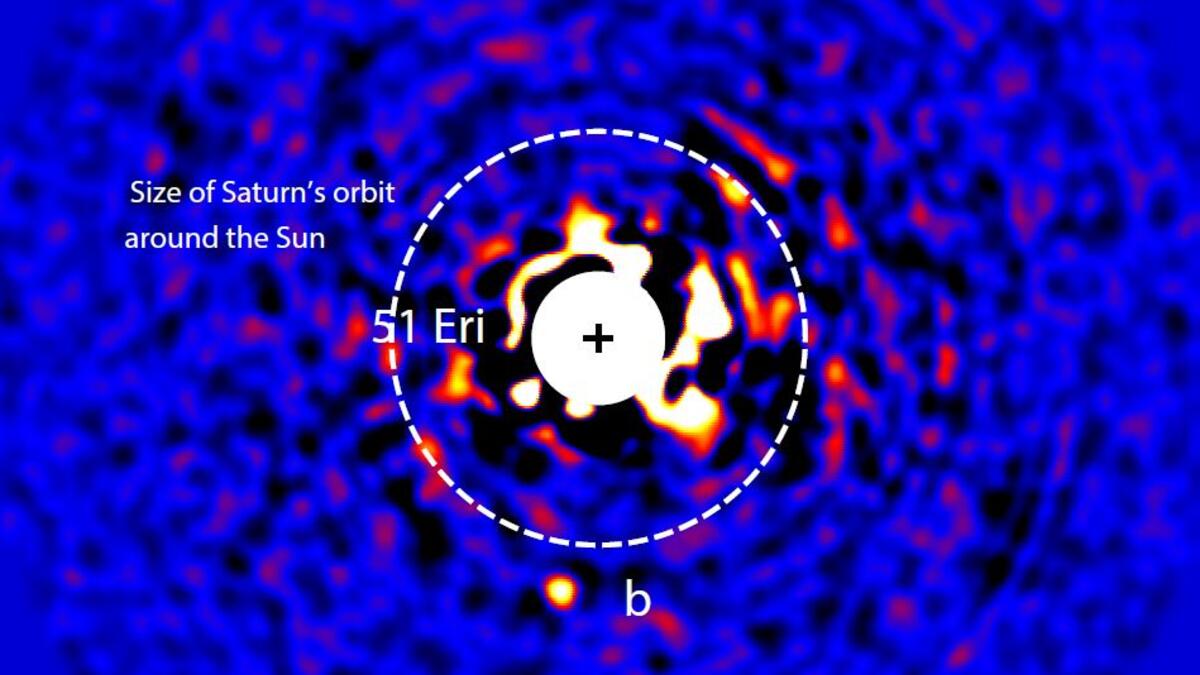Astronomers discover 'Young Jupiter' exoplanet

Discovery image of the planet 51 Eridani b with the Gemini Planet Imager taken in the near-infrared light on Dec. 18, 2014. The bright central star has been mostly removed to enable the detection of the exoplanet 1 million times fainter.
ASU team helps lead development of star survey
One of the best ways to learn how our solar system evolved is to look to younger star systems in the early stages of development. Now, a team of astronomers has discovered a Jupiter-like planet within a young system that could serve as a decoder ring for understanding how planets formed around our sun.
The new planet, called 51 Eridani b, is the first exoplanet discovered by the Gemini Planet Imager. It is a million times fainter than its star and shows the strongest methane signature ever detected on an alien planet, which should yield additional clues as to how the planet formed.
The results are published in the current issue of Science.
A clear line of sight
The Gemini Planet Imager (GPI) was designed specifically for discovering and analyzing faint, young planets orbiting bright stars by direct imaging. NASA's Kepler mission indirectly discovers planets by the loss of starlight when a planet blocks a star.
“To detect planets, Kepler sees their shadow; GPI sees their glow,” said Bruce Macintosh, professor at Stanford University who led the construction of GPI and now leads the survey.
To directly image planets, astronomers use adaptive optics to sharpen the image of a star, and then block out the starlight. Any remaining incoming light is then analyzed, the brightest spots indicating a possible planet.
After GPI was installed on the 8-meter Gemini South Telescope in Chile, the team set out to look for planets orbiting young stars. They’ve looked at almost a hundred stars so far.
“This is exactly the kind of planet we envisioned discovering when we designed GPI,” says James Graham, professor at UC Berkeley and Project Scientist for GPI.
A team from Arizona State University and the University of Georgia led the development of the target sample for the 600-star survey.
“By targeting young stars, we can catch planets while they are hotter and brighter and can study how planets evolve over time,” said ASU astrophysicist Jennifer Patience, an associate professor in the School of Earth and Space Exploration and part of the GPI Exoplanet Survey Team.
As far as the cosmic clock is concerned, 51 Eridani (51 Eri) is young — only 20 million years old — and this is exactly what made the direct detection of the planet possible. When planets coalesce, material falling into the planet releases energy and heats it up. Over the next hundred million years they radiate that energy away, mostly as infrared light.
Once the astronomers zeroed in on the star, they blocked its light and spotted 51 Eri b orbiting a little farther away from its parent star than Saturn does from the sun. The light from the planet is very faint – more than 3 million times fainter than its star – but GPI can see it clearly. Observations revealed that it is roughly twice the mass of Jupiter. Other directly imaged planets are five times the mass of Jupiter or more.
In addition to being the lowest-mass planet ever imaged, it’s also the coldest — 800 degrees Fahrenheit, whereas others are around 1,200 F — and features the strongest atmospheric methane signal on record. Previous Jupiter-like imaged planets have shown only faint traces of methane, far different from the heavy methane atmospheres of the gas giants in our solar system.
All of these characteristics, the researchers say, point to a planet that is very much what models suggest Jupiter was like in its infancy.
Of course, it’s not exactly like Jupiter. The planet is so young it still has a temperature of 800 Fahrenheit, hot enough to melt lead and similar to the temperature of Venus.
“Our analysis of the brightness of 51 Eri b at different colors immediately showed us that we were looking at something unique and exciting,” Patience said. She and her graduate students Abhi Rajan and Kim Ward-Duong led the comparison with atmospheres of other known imaged exoplanets and brown dwarfs (objects intermediate between stars and planets) to investigate the nature of 51 Eri b.
The key to the solar system?
In addition to expanding the universe of known planets, GPI will provide key clues as to how solar systems form. Astronomers believe that the gas giants in our solar system formed by building up a large core over a few million years and then pulling in a huge amount of hydrogen and other gases to form an atmosphere.
But the Jupiter-like exoplanets that have so far been discovered are much hotter than models have predicted, hinting that they could have formed much faster as material collapses quickly to make a very hot planet. This is an important difference. The core-buildup process can also form rocky planets like the Earth; a fast and hot collapse might only make giant gaseous planets. 51 Eri b is young enough that it "remembers" its formation.
Simulated fly-by of the 51 Eridani star and planet system from Franck Marchis on Vimeo.
More Science and technology

ASU researcher part of team discovering ways to fight drug-resistant bacteria
A new study published in the Science Advances journal featuring Arizona State University researchers has found…

ASU student researchers get early, hands-on experience in engineering research
Using computer science to aid endangered species reintroduction, enhance software engineering education and improve semiconductor…

ASU professor honored with prestigious award for being a cybersecurity trailblazer
At first, he thought it was a drill.On Sept. 11, 2001, Gail-Joon Ahn sat in a conference room in Fort Meade, Maryland.…